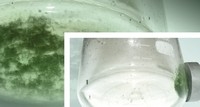
The research team, based in Germany, showed that particularly fast-growing species of algae will accumulate on magnetic particles when they are added to a cultivating mixture.
Manfred Ruehrig, a senior research scientist at Siemens, said that his team demonstrated this in the laboratory with three grams of algae in three litres of water, but that the same principle could be scaled up into large industrial bioreactors.
‘We would grow the algae either in open pond or closed bioreactors,’ he said. ‘When the growth rate reaches its maximum, some of the water, including the algae biomass, would be continuously removed in a separate process where it is mixed with a special type of magnetite. It would then be mechanically stirred to let the algae firmly attract to the magnetite.’
According to Ruehrig, this would magnetically ‘activate’ a certain amount of the biomass that could be subsequently extracted via a magnetic separation process.
He suggested using a rotating drum with permanent magnets — a type of equipment used in industries such as steel mills or waste treatment plants where it is necessary to separate magnetic and nonmagnetic components.
‘Of course those industries deal with large pieces of magnetic material,’ said Ruehrig. ‘In our case, we are dealing with micrometre-sized
particles so the equipment would look a little bit different but the physical principle is very similar.’
He said that this process is more efficient than current algae-harvesting methods. It is usually a chal-lenge to harvest algae because a litre of water contains only a few grams of it. Traditionally, algae is extracted by draining the water and filtering it in a complex and time-consuming process.
One of the advantages of the new magnetic process is that there is less water loss, meaning that algae can be considered for harvesting in
drier areas.
The amount of algae harvested can be determined by varying the amount of magnetite used. Thus, the amount of algae left behind to form the starting stock for the next population can be adjusted.
Algae can be grown using land and water unsuitable for plant or food production, unlike some other firstand secondgeneration biofuel feedstocks
Source: ExxonMobil
Ruehrig said that the magnetic harvesting process would require removing the magnetite from the algae before it is used as raw material
for biomass, biogas or biodiesel. ‘The magnetic particles should be removed at a certain stage of the process because the magnetite is a valuable product, so they should be recovered to make the process economically feasible,’ he said.
However, Ruehrig did add that the fermentation process for biogas, for example, would not be disturbed by the particles.
So far, the new technology has only been used at the laboratory scale, but the researchers are confident that it will also work on a larger scale.
According to Ruehrig, the team is currently looking for partners within Siemens and externally to help it take its technology to the next step — the construction of a pilot plant for conducting further tests of the scalability and efficiency of the method.










Water Sector Talent Exodus Could Cripple The Sector
Well let´s do a little experiment. My last (10.4.25) half-yearly water/waste water bill from Severn Trent was £98.29. How much does not-for-profit Dŵr...